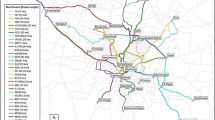Abstract
The paper considers the technological development of rapid bus routes in the network of Vilnius public transport. All rapid bus routes of the scheme for Vilnius public transport are presented and analysed with reference to the selected system of criteria. This article describes the situation of the public transport system in Vilnius and shows the influence of rapid bus routes. The paper also analyses parameters for the lines used for the multiple attribute ranking of rapid bus routes in Vilnius city. Multi-criteria methods have been chosen to rank six rapid bus routes and to estimate the best and most effective alternative based on the preferred technological and financial data. The experts of different decision-making groups have analyzed the importance of parameters selected for assessing alternatives to ranking rapid bus routes. The experts on the transport system have been invited to determine the relative weights of the defined criteria. Three techniques, including analytical hierarchical process, simple additive weighting and TOPSIS methods have been used and compared to determine the most efficient rapid bus route based on economic and technological parameters. To rank alternatives and to make a comparison of the obtained calculation results, three multi-criteria methods have been applied in this research.






Similar content being viewed by others
References
Achillas C, Vlachokostas C, Moussiopoulos N, Banias G (2011) Prioritize strategies to confront environmental deterioration in urban areas: multi-criteria assessment of public opinion and experts’ views. Cities 28(5):414–423. doi:10.1016/j.cities.2011.04.003
Airaksinen S, Virpi K-R (2012) Bus priority as a competitive factor. Thesis pending, WSP Finland Ltd.
Bharat P, Odd I (2011) Are intrazonal trips ignorable? Transp Policy 18(1):13–22. doi:10.1016/j.tranpol.2010.04.004
Black JA, Paez A, Suthanaya PA (2002) Sustainable urban transportation: performance indicators and some analytical approaches. J Urban Plan Dev 128(4):184–209. doi:10.1061/(ASCE)0733-9488(2002)128:4(184)
Brauers WK, Ginevicius R, Podviezko A (2012) Evaluation of performance of Lithuanian commercial banks by multi-objective optimization. In: Ginevicius R, Rutkauskas AV, Stankeviciene J (eds) The 7th international scientific conference business and management’2012. Selected papers: 1042–1049. Technika, Vilnius, Lithuania
Brauers W, Ginevicius R, Podviezko A (2014) Development of a methodology of evaluation of financial stability of commercial banks. Panoeconomicus 61(3):349–367. doi:10.2298/PAN1403349B
Čiegis R, Gineitienė D (2008) A concept of sustainable development for regional land use planning: Lithuanian experience. Technological and economic development of economy. Baltic J Sustain 14(2):107–117. doi:10.3846/1392-8619.2008.14.107-117
Drobne S (2003) Modelling accessibility fields in slovene municipalities. In: Proceedings of the 7th symposium on operation research in Slovenia (SOR’03), pp 89–96
Fernández R (2010) Modelling public transport stops by microscopic simulation. Transp Res Part C: Emerg Technol 18(6):856–868. doi:10.1016/j.trc.2010.02.002
Ginevicius R, Podviezko A (2013) The evaluation of financial stability and soundness of Lithuanian banks. Ekonomska Istrazivanja-Econ Res 26(2):191–208
Ginevicius R, Podvezko V, Podviezko A (2012) Evaluation of isolated socio-economical processes by a multi-criteria decision aid method ESP. In: Ginevicius R, Rutkauskas AV, Stankeviciene J (eds). The 7th international scientific conference business and management’2012. Selected papers: 1083–1089. Technika, Vilnius, Lithuania
Joumard R, Nicolas J (2010) Transport project assessment methodology within the framework of sustainable development. Ecol Ind 10(2):136–142. doi:10.1016/j.ecolind.2009.04.002
Kendall MG, Gibbons JD (1990) Rank correlation methods, 5th edn. Edward Arnold, London
López-Neri E, Ramírez-Treviño A, López-Mellado E (2010) A modelling framework for urban traffic systems microscopic simulation. Simul Model Pract Theory 18(8):1145–1165. doi:10.1016/j.simpat.2009.09.007
Maskeliūnaitė L, Sivilevičius H (2012) Expert evaluation of criteria describing the quality of travelling by international passenger train: technological, economic and safety perspectives. Technol Econ Dev Econ 18(3):544–566. doi:10.3846/20294913.2012.710178
Opricovic S, Tzeng GH (2004) Compromise solution by MCDM methods: a comparative analysis of VIKOR and TOPSIS. Eur J Oper Res 156(2):445–455
Podvezko V (2007) Determining the level of agreement of expert estimates. Int J Manag Decis Mak 8(5/6):586–600
Podvezko V (2009) Application of AHP technique. J Bus Econ Manag 10(2):181–189
Podviezko A (2012) Augmenting multicriteria decision aid methods by graphical and analytical reporting tools. In: Niedrite L, Strazdina R, Wangler B (eds) Workshops on business informatics research, vol 106. Springer, Berlin Heidelberg, pp 236–251. doi:10.1007/978-3-642-29231-6_19
Polydoropoulou A, Roumboutsos A (2009) Evaluating the impact of decision making during construction on transport project outcome. Eval Progr Plan 32(4):369–380. doi:10.1016/j.evalprogplan.2009.06.016
Saaty TL (1977) A scaling method for priorities in hierarchical structures. J Math Psychol 15(3):234–281
Saaty TL (1990) How to make a decision: the analytic hierarchy process. Eur J Oper Res 48(1):9–26. doi:10.1016/0377-2217(90)90057-I
Sivilevičius H (2011) Modelling the interaction of transport system elements. Transport 26(1):20–34. doi:10.3846/16484142.2011.560366
Sivilevičius H, Zavadskas EK, Turskis Z (2008) Quality attributes and complex assessment methodology of the asphalt mixing plant. Baltic J Road Bridge Eng 3(3):161–166. doi:10.3846/bjrbe.2011.07
Special plan for new modes of transport deployment in Vilnius city. Conception. Vilnius Gediminas Technical University, 2012
Susnienė D (2012) Quality approach to the sustainability of public transport. Transport 27(1):102–110. doi:10.3846/16484142.2012.668711
Tsekeris T, Souliotau A (2014) Graph-theoretic evaluation support tool for fixed-route transport development in metropolitan areas. Transp Policy 32:88–95. doi:10.1016/j.tranpol.2014.01.005
Ušpalytė-Vitkūnienė R, Grigonis V, Paliulis G (2012) The extent of influence of O-D matrix on the results of public transport modeling. Transport 27(2):165–170. doi:10.3846/16484142.2012.693894
White Paper (2011) Roadmap to a single European transport area—towards a competitive and resource efficient transport system. Brussels, 28.3.2011 COM(2011) 144 final
Wu Z, Flintsch GW, Chowdhury T (2008) Hybrid multiobjective optimization model for regional pavement–preservation resource allocation. Transp Res Rec 2084:28–37. doi:10.3141/2084-04
Yoon K, Hwang CL (1995) Multiple attribute decision making: an introduction. Sage Publications, Thousand Oaks
Zavadskas EK, Banaitienė N, Kaklauskas A (2001) Multiple criteria analysis of a buildings life cycle. Vilnius, Technika, p 380
Zavadskas EK, Zakarevičius A, Antuchevičienė J (2006) Evaluation of ranking accuracy in multi-criteria decisions. Informatica 17(4):601–618
Zavadskas EK, Kaklauskas A, Peldschus F, Turskis Z (2007) Multi-attribute assessment of road design solutions by using the COPRAS method. Baltic J Road Bridge Eng 2(4):195–203
Author information
Authors and Affiliations
Corresponding author
Rights and permissions
About this article
Cite this article
Jakimavičius, M., Burinskienė, M., Gusarovienė, M. et al. Assessing multiple criteria for rapid bus routes in the public transport system in Vilnius. Public Transp 8, 365–385 (2016). https://doi.org/10.1007/s12469-016-0146-7
Accepted:
Published:
Issue Date:
DOI: https://doi.org/10.1007/s12469-016-0146-7




